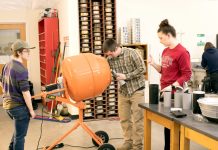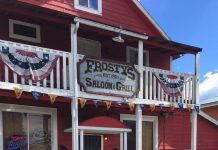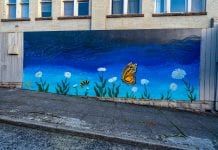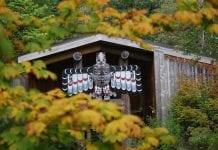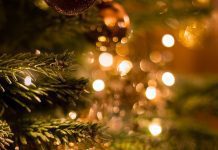The term ghost town conjures the image of a desolate abandoned place. Technically, Claquato is a ghost town but not because it has been abandoned to dereliction. The location where the town of Claquato once was is now a neighborhood near Chehalis. And though Claquato was once the Lewis County Seat, only two landmarks remain — The church and the cemetery.
The area was named by the Native Americans before any pioneers appeared on the scene. The term means “high land” or “high prairie.” According to historian Roscoe Doane, the area was a seasonal campsite for the Indians whose hunting and fishing trails led down to the Chehalis and Neuwaukum Rivers. “Further evidence of their presence was their burial ground to the east, just near the foot of the hill,” writes Doane.
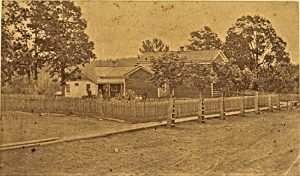
Claquato became a Donation Land Claim when Lewis Hawkins Davis (1794-1865) arrived in 1851 after traveling west with a wagon train from Independence, Missouri. The site was ideal because it was only partly timbered which saved the effort of clearing it for construction and pasture. Davis quickly built a log home with his wife, Susan, and their family.
The entire region was sparsely populated by a few families and single men like John R. Jackson and Sidney Ford. When Washington became its own Territory in 1853, the opportunity to lay claim to more than just a homestead was a real possibility. Lewis H. Davis envisioned a road system and a town up on his “high ground” to welcome the influx of settlers coming into the territory.
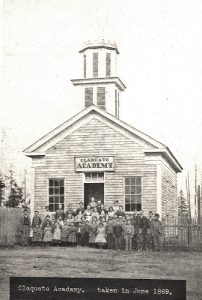
He and his sons set to work creating roads. The first led over the hill and down to the confluence of the Skookumchuck and Chehalis Rivers near the Borst’s home. The roads Hawkins created not only encouraged pioneers to pass through, but to settle in the area. At least one of Hawkins’ roads would later be incorporated into the military road system during the Indian Wars.
In the early days, the Davis family didn’t have facilities for travelers but they did have a large fir tree near their home which they encouraged folks to camp under, as it provided some shelter from the sun and rain. This fir tree still stands prominently in Claquato Cemetery. It bears a plaque that reads, “Claquato Pioneer Fir. A Shelter for First Settlers. Dedicated in 1937 as a Memorial to their Fortitude.”
Phoebe Goodell Judson, author of her memoir A Pioneer’s Search for an Ideal Home has this to say of Claquato, “Esq. Davis called his prairie Claquato, an Indian name for high land. A road was cut through the heavy timber by the settlers, from the prairie to the mouth of the Skookumchuck River, and other roads radiating from this point made Claquato a very pretty little town—nature having been lavish in her adornments, the scene was of picturesque beauty.”
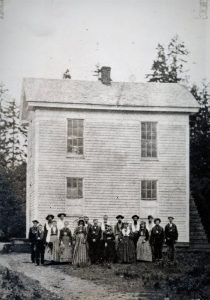
As travel through the Territory and its settlement increased, so to did tensions with the Native People who already called this region home. In 1855-1856 the Indian Wars came to Thurston County and created unease in Lewis County as well. Forts were erected throughout the area including one in Claquato. The Judsons took refuge in this fort and Phoebe wrote that it “was built of heavy timbers and enclosed by a palisade of fir and cedar posts, twelve feet in height, driven firmly into the ground. Portholes were made in the walls of the blockhouses, through which we might defend ourselves from the enemy.”
Life went on in the fort, with many settlers leaving by day to tend to their fields and livestock. There was a wedding at the fort as well as death. Mary Spinning, who was just a toddler, was famously the first to pass in Claquato. Because of her, Davis donated a portion of his land to create Claquato Cemetery. The families of the fort were deeply affected by her death.
“The saddest event was the death of little Mamie (Mary) Spinning,’ wrote Judson. “We all loved the bright little prattler, with the dark, expressive eyes and the sweet, innocent face, and we followed, as one family, with the sorrowing parents, the precious form from which the bright jewel had fled, to the little grave on the hillside near a small grove of evergreen trees and sang “Sister Thou Wast Mild and Lovely.” Being a very impressive scene, and the first burial any of us had attended in the country.”

After the war, which amounted to little in Lewis County, Davis once again looked to the development of his beloved town. He built a sawmill in 1857, the first lumber of which was used to build the Claquato Church which was dedicated in 1858. With the production of lumber, the village quickly grew to boast two hotels, a blacksmith shop, a carpentry and cabinet shop, livery stable, general store, the church and parsonage, a cable ferry and homes. The sawmill was also used to mill grain. Davis set aside land to build a two-story courthouse in 1862 which was deeded over to Lewis County, making Claquato the county seat.
The little pioneer church which also served as a school is still standing today, restored to its original condition. The foundation and structure are original, making it the oldest church in Washington State. Even the original bell, cast in Boston in 1857, is still there. The most striking aspect of the church is its crown of thorns steeple. Special services and events are held there on occasion.
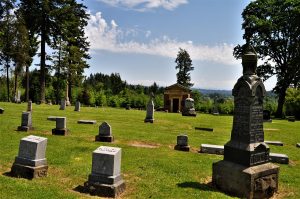
It is useful to stop at the church first when visiting Claquato since there is a map of the Pioneer Village posted outside. The Claquato Cemetery office also contains photographs and historic displays. While in the cemetery you may visit the Pioneer Fir on your way to the old section of the cemetery at the top of the hill. In this older section look for Mary Spinning’s grave as well as that of Lewis Hawkins Davis.
Davis passed in October of 1865 after a fall at his sawmill. And Claquato, which had thrived as a stagecoach town, began to slip into obscurity with the coming of the railroad in 1874. The plat for the town was vacated in 1902.
For Continued Reading:
There is plenty to read about the Landmarks of Claquato in the Lewis County Historical Museum. Much effort was made in the 1930s to research and catalog the people and landmarks of Claquato in the newspaper, the Chehalis Bee-Nugget.
Pioneer Reminiscences of Lewis County by Mabel C. Dressler. 1939
A Pioneers Search for an Ideal Home by Phoebe Goodell Judson. 1925

1860 pioneer village of Claquato. Photo courtesy: Lewis County Historical Museum.









